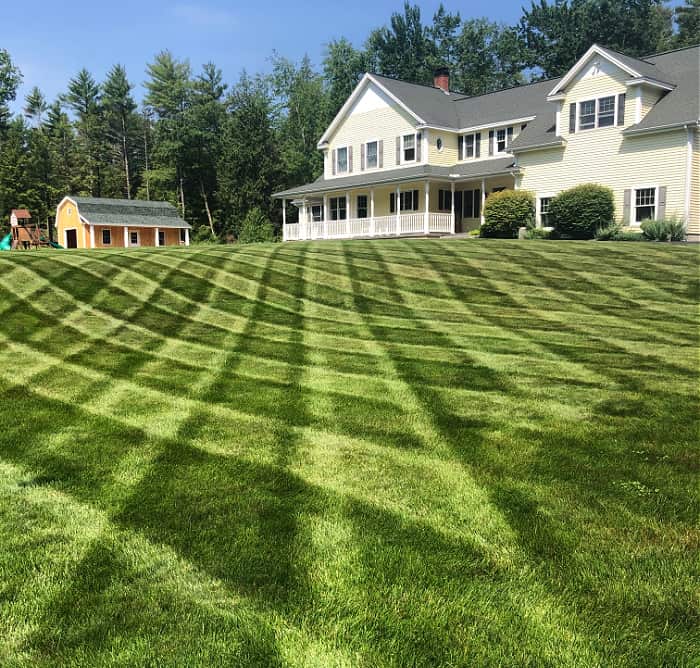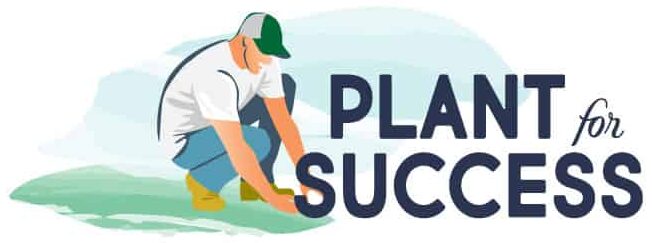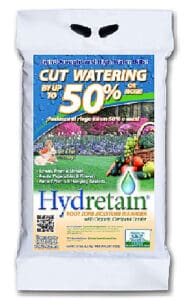Yes, it is possible to have green grass all summer long. Use these summer lawn care tips to help your lawn win the battle against summer lawn problems.

Summer lawn care can be challenging, especially for those of us with cool season lawns (Kentucky Bluegrass, Perennial Rye, and Fescues). Unlike warm season lawns which do much better in the summer heat, cool season lawns are at their highest point of stress.
Your lawn may even turn a light brown as it enters a period of summer dormancy. If conditions don’t improve your dormant grass will eventually die.
Of course these problems are much more likely to occur for those without a way to irrigate through drought like conditions. Although there’s no perfect way to avoid the damages caused by the most extreme summer weather conditions, there are some summer lawn care tricks you can do that can save your lawn and maybe even keep it green all summer long.
Early Identification of Summer Lawn Stress
A lot of people ignore the early stages of summer lawn stress. Most people wait for their lawn to turn brown to acknowledge it’s time take action and water dry areas. But acting earlier has its benefits. It’s a lot easier to keep soil moist then to try and get it back to moist once it goes completely dry. Instead of waiting for lawn areas to go completely brown, look for areas of your lawn that turn a blue/grayish color. This is an early sign that your lawn is thirsty. Take a look below:

If you see areas like this, intervene early. You don’t necessarily have to irrigate the entire area. Since these are specific areas, get the hose out and do some hand watering. A little bit of target watering with the hose goes a long way.
Use Hydretain
Hydretain is one of the best kept secrets in the DIY lawn space. Ever wonder how golf courses stay so green, even throughout the summer? You would think they’d have to be constantly irrigating. Yes, they do irrigate, but their irrigation needs are drastically reduced due to a product called Hydretain.
Think of Hydretain as a tiny water magnet for your lawn. It collects moisture from the soil where it would normally be lost due to evaporation. This moisture gets delivered to the root zone of your lawn. The science of it is actually really cool and I encourage you to check it out here: Hydretain Science
I was skeptical of this product at first but figured I’d try it as an experiment. We ended up having one of the driest summer seasons ever here in NH, (2020). My lawn remained green throughout the summer, and I believe a lot of that has to do with the Hydretain. Yes, I do have an irrigation system, but I was pushing my well so hard that I was really limited with using it.
Hydretain makes claims that it will save you 50% in water usage. I couldn’t tell you if that’s true or not. I can tell you that it will definitely help your lawn retain moisture during the heat of the summer. It might be just enough to get your lawn through those really bad dry spells.
Apply Hydretain, in granular form (or liquid), to your entire lawn once in the beginning of the summer. According to the label the effects last for up to 3 months which is usually enough time to get over those bad summer months.
Reduce Nitrogen and Increase Potassium
As you head into the heat of the summer, back off on fertilizers that are high in nitrogen. Nitrogen pushes blade growth. This is fine for most of the year but when grass becomes stressed, trying to force it to grow will only stress it out more. Also, increased nitrogen levels can increase the likelihood of fungus’ such as brown patch.
Instead of nitrogen use a fertilizer that has a higher percentage of potassium, the third number on the fertilizer label. Potassium helps plants (and grass) in 4 ways:
1. Resists Against Stress and Disease- Strengthens the cells of the plant which helps it fight against extreme weather conditions and disease.
2. Regulates Water Carrying System- Regulates water pressure within the plant. This ensures that all parts of the plant receive water.
3. Facilitates Nutrient Uptake and Strengthens Roots- Strengthens roots and makes it easier for roots to take in nutrients.
4. Helps Process of Photosynthesis- Potassium helps facilitate plant development by helping the process of photosynthesis.
Use Slow Release Nitrogen
If you’re going to apply a little nitrogen during the heat of the summer, use slower release nitrogen. Slow release fertilizers are more organic than synthetic fertilizers. They also contain less salt and break down slower, providing a slower release of nutrients. This will help prevent your lawn from burning, especially in its weakened state.
Taking into consideration the need for higher potassium, and reduced nitrogen levels heading into summer, my go to fertilizer for summer is (affiliate) Stress blend 7-0-20. It is slow release, contains Bio Nite which is a natural bio solid, and it also contains iron as well as other micronutrients. I apply this product once right before we hit our hottest weeks of summer.
Adjust Irrigation
There are 2 types of irrigation you want to focus on during the summer months. One is a deep watering to get to the root system, and the other is a quick cool down watering to decrease soil temps and manage heat stress.
1. Deep Watering- If you do have irrigation then use it to your advantage. Watering for a longer period of time, and less often, will grow deeper roots. Deeper roots give grass a better chance of surviving during dry conditions. During the heat of the summer, you need to adjust your irrigation so it runs for an even longer period of time then normal to get the water to reach deep enough to water the roots. The reason it takes more water during the summer is because during the summer months the soil gets dry. It takes a lot of water just to get the soil surface wet enough so that additional water can pass through and reach the root zone.
Many people make the mistake of watering more frequently during the summer months when what they really need to do is increase watering duration.
2. Cool Down Watering- Adding a quick cool down watering cycle during the heat of the day will help cool the soil temperature and manage heat stress. These cool down cycles can make a huge difference. I usually run each zone for about 7-10 minutes at 1 o’clock in the afternoon. At my house, this is when the sun is really beating down on the lawn in the middle of summer.
This cool down watering sounds contradictory to the water deep but less frequently approach, but the two types of watering are not the same. With the cool down watering the intention isn’t to water the roots, it’s just to cool soil temps along the surface of the lawn to help manage with heat stress. This cool down watering is only necessary in sunny days with air temps 85 degrees or higher.
If you don’t have an irrigation system consider building a temporary setup using hoses and sprinkler heads. Ryan Knorr does a great video on building a temporary system. check out his tutorial here: Temporary Sprinkler Setup
Increase Mowing Height and Sharpen Blades
Longer grass blades provide natural shade and help prevent the soil from drying out. I like to increase my height of cut from 3” to 3.5”, sometimes even up to 4” during the mid summer months. You might find that blade growth slows down a lot during the heat of the summer. Simply back off on mowing. You can go to a ten day schedule, or even skip a week. Don’t mow if there is not a need to!
Also, early summer is a great time to get a fresh edge on your mower blades. Getting a nice crisp cut on the top of your leaf blades will help the grass quickly recover after mowing and will help resist against disease.
Spot Spray Weeds
Weeds, especially clover can take advantage of your lawns weakened state. Target these weeds with a lawn safe herbicide to prevent them from taking over. Just be careful when applying herbicides during the summer months. You don’t want to apply herbicides to a lawn that is already showing signs of heat stress or drought. Also you don’t want to apply herbicides when temps are above 85 degrees. Your best bet is to manage weeds as best as possible before facing the stressors of summer. Once the summer stressor period is over, continue to spot spray weeds.
Increase Water Retention In Soil
If your lawn usually suffers during the summer months, a big problem could be in the soil. Sandy soil, and clay soils are more likely to be negatively impacted by harsh summer conditions. Incorporating compost into your lawn will help amend soil and increase water retention. Compost is special since it adds water retention in sandy soil, but in clay soil it creates much needed drainage and air flow. The best way to add compost to your lawn is to first core aerate, and then top dress with compost. After core aerating and top dressing you can go a step further and overseed.
Adding compost to your soil via core aerating and top dressing should be done before or after the stressors of summer, not during the summer months.
Overseed with TTTF
TTTF, or Turf Type Tall Fescue, is one of the most drought tolerant (and attractive) grasses there is for those of us in cool season lawn regions. The main reason it does so good in the heat is because its roots grow 2′-3′ deep. So while the surface of the soil may be dry, down deep there is more moisture.
Now, I’m not saying you should overseed with TTTF in the middle of summer. In fact, that would be a really bad idea. But if you want to gradually convert your lawn to more TTTF, then wait until early fall and Core Aerate and Overseed with TTTF. A great place to purchase TTTF is here: GCI TTTF
Don’t Rake Your Stressed Lawn
One of the biggest mistakes I see people make is raking brown spots in their lawn in the middle of summer. You probably think it’s a good idea to rake out damaged leaf blades, but you’re actually doing way more bad than good.
You have to think of grass as being a plant. While yes, the leaves may be damaged, but the overall plant is not. What you don’t see is that right at the soil is the crown of the plant. Inside that crown is a tiny bit of life. You may even see a little bit of green if you look close enough.
Once your grass receives water again this little bit of green will grow out. That is why your lawn that looks dead in the summer can come back to life after a good rain. This crown is very fragile though, and if you start raking it you could damage it. The best thing you could do is water brown/tan areas and leave the rake in the garage for the summer!
Check Out These Posts Next
Preventing and Treating Lawn Fungus
Lawn Care Schedule Using Only 3 Products
The Importance of Soil Temperature in Your Lawn
Follow Me
Join my free email list!
Plus, follow me on Facebook, Instagram, and Pinterest.



Thanks for the great info Mark… I think I’m going to give the Hydretain and the Stress Blend fertilizer a try this year. I usually use straight synthetic fertilizer heading into summer and I think it’s adding to the burn I get in my lawn every summer.
Hi Shawn! Sounds like you have a good plan. Switching to the stress blend is a much better fertilizer heading into summer. In addition to the increased potassium, it is slow release and less likely to burn then purer synthetic fertilizers.
Hi Mark!
I love reading your blog as I am so new to this stuff. I laid sod down in early may (by myself) and have been watering thoroughly. We have had extremely high temps lately and our first rain in 2 weeks last night. While I’ve continued to water , the grass is turning brown and weeds are popping up everywhere!!! Any recommendations for products to assist?
Hi Abby! Happy to hear you’re enjoying the blog! Where are you located? Assuming it cool season grass there could be a number of reasons why your sod is turning brown. The most obvious one is that it is drying out in between waterings. With new sod you pretty much want to keep it moist constantly. To do this you’re better off with several shorter watering cycles throughout the day instead of just one long watering. The good news is we are heading into the fall which is a great time to renovate any problem areas in your lawn (for cool season lawns). I would try and do your best to water from now until mid september. At that point broadleaf weeds should start to die back and you can top dress problem areas and reseed. Feel free to send me some pics to my email and I can help you out a little more: [email protected]
Mark, any advice on sprinklers that provide even coverage? I have an oscillator that seems to do mostly OK for large areas, but in smaller areas the coverage varies widely. I use a plastic kitchen measuring cup and I can see 2-3 times as much water in some areas vs others.
Mark, I live in the Texas Panhandle and have a fescue lawn. It is flowering right now and I see that you suggest Flagship 20-0-7. Temps are starting to get into the high 80’s and low 90’s. Next month they will probably hit 100. Can I apply the 24-0-7 now and then the 7-0-20 next month? I have clay soil. Also every year for the past four years I’ve had a portion of my yard to die, the same places every time. My yard looks great in May. I was told it was a fungus, but I don’t know. I can over seed and it will come up and then die. I also did a soil test and everything was high, especially sodium. I’ve applied gypsum several times. Thanks for your info.
Billy
Hi Billy, you can use the Flagship 24-0-7 now and then the stress blend when you get hotter in another month. You could also use Milorganite 6-4-0 now which is very slow release and pretty much organic. Milorganite doesn’t have the salt that synthetic fertilizers have. I’d probably use Milorganite for a couple of your lawn application since that’s your friend in the heat. Next month when you start getting really hot, back off on the nitrogen. Like you said, Stress Blend would be a better choice then. As for portions of your lawn dying, I couldn’t tell you without looking at it but I will say investigate. I spend so much time with my face literally in the lawn studying the leaf blades as they become damaged. Check for spots. Also dig into the ground and check the soil. Is it dry, clay like you said? Maybe watering during the really hot times is the answer. Also check out this post for fixing clay soil https://plantforsuccess.com/growing-grass-clay-soil/
Thank you for the information. I’m glad I found your column. I have purchased the 7-0-20 and Hydretrain.
I have a question about the 7-0-20. I had my soil analyzed three different times. Everything was high except nitrogen. With the potassium number already high, would you still advise to use the 7-0-20th now that it is getting hot?
Thanks